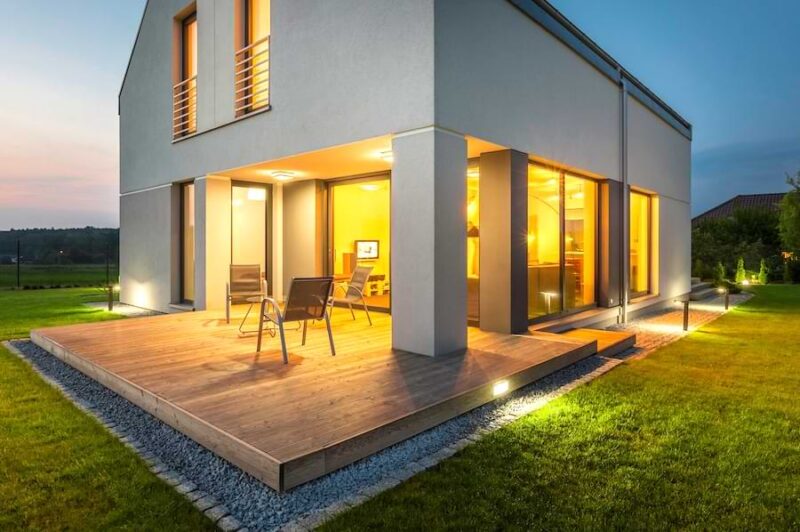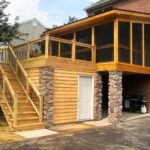How to light your deck for enjoyable evenings with family and friends. Inspiring deck lighting ideas!
In recent years, decks have become very popular for outdoor gatherings, socializing, and relaxing. To fully embrace the enchantment of evening gatherings, outdoor lighting has emerged as an essential element—lighting can transform deck areas into safe, inviting nighttime retreats. In this article, we’ll explore various deck lighting ideas, the different types of deck lights available, how to choose between low-voltage and standard-voltage lighting, and more.
Types of Outdoor Deck Lighting
With a wide array of outdoor deck lighting choices at your disposal, you can create a captivating and inviting outdoor space to enjoy after dark. From wall-mounted sconce lights to landscape light fixtures, each option brings its charm, beauty, and added safety. Whether you prefer subtle illumination or a more festive ambiance, there’s a deck lighting solution to suit your style and elevate your outdoor gatherings to new luminous heights. Choices in deck lighting include:
Deck Railing Lights
Deck railing lights are designed to be installed directly onto or within the deck railing, adding both functional illumination and a decorative element to the railing structure. You can get cap lights for the top of the railing, under-rail lights, or side-mount lights.
Pros: Easy to install and available in a wide variety of styles.
Cons: Most types have limited reach of illumination.
Deck Post Lights
Deck post lights (or post cap lights) are installed on top of railing posts to provide ambient and practical illumination. They come in many styles and sizes, allowing you a wide choice of options that can blend seamlessly with your deck’s design.
Pros: Easy to install, versatile, and provide 360-degree illumination.
Cons: May cast some shadows on the deck surface.
Step Lights
Step lights (or deck stair lights) enhance safety by illuminating treads and risers on outdoor staircases. They can be mounted on the sides of steps or recessed into the stair risers themselves.
Pros: They ensure that family and guests safely traverse stairs and create an elegant look.
Cons: Cutting-in step lights often requires professional installation.
Recessed Deck Lights
Floor lighting is installed flush with a deck’s surface, giving the deck a smooth, modern appearance. They offer subtle illumination and minimize tripping hazards.
Pros: Discreet and low-profile, making them perfect for floor lighting on small decks.
Cons: Installation calls for cutting into the deck surface, which can be labor-intensive. This type of up-lighting can shine in guests eyes if not done right.
Wall-mounted Lights
Light fixtures mounted on walls (often called “sconces”) that are adjacent to a deck are a versatile option for deck lighting, offering general ambient lighting or highlights.
Pros: Wall lights are relatively easy to install where electricity is available, space-saving.
Cons: Limited coverage area compared to some other types.
Landscape Lighting
Landscape lighting extends beyond the deck, highlighting surrounding plants, pathways, and garden features. It creates a captivating ambiance and enhances the overall outdoor experience.
Pros: Adds depth to the landscape at night, and improves safety.
Cons: Some types require professional installation for optimal positioning.
Skirt-board Lights
Skirt-board lights are installed in a deck’s skirt boards, providing subtle and charming illumination to the deck’s perimeter.
Pros: Concealed lighting adds a touch of elegance, enhances deck aesthetics, and improves safety.
Cons: Most require wiring and installation during deck construction.
Bollard Lights
Bollard lights (shown above) are knee- to waist-high freestanding fixtures or posts that can be strategically placed around the deck’s perimeter, guiding guests and adding style and visual interest.
Pros: Easy to install, versatile.
Cons: Some models may require wiring and professional installation.
Overhead House Lights
Overhead lights, such as porch or patio lights, offer indoor-outdoor ambient lighting by illuminating the deck from above.
Pros: Already existing fixtures, cost-effective, and provide general illumination for the deck area.
Cons: May not be specifically designed for deck ambiance.
Bistro Lights
Bistro lights, also known as hanging string lights or café lights, create a warm and enchanting atmosphere on the deck. They are strung overhead between posts or trees.
Pros: Inexpensive, easy to install, and add a cozy, festive feel with their soft glow.
Cons: Most are only temporarily installed and are not suitable for permanent, year-round use.
Lamps and Candles
Portable lamps and candles are a charming and flexible lighting solution for decks. Placed strategically on tables or surfaces, they offer a soft glow for quiet conversations and relaxing.
Pros: Portable, versatile, and offer a soft, intimate ambiance.
Cons: Require regular maintenance, and generally don’t provide enough light for larger areas.
Creative Lighting Accents
Beyond conventional outdoor light ideas, creative lighting solutions, such as a brightly lit umbrella, glow-in-the-dark stones, pendant lights, rope lights, or LED deck light strips, can add a whimsical touch to your deck.
Pros: Unique, customizable, and allow for personal expression.
Cons: Some options may have limited illumination and require specialized setup.
Solar Deck Lights
Solar-powered deck light fixtures harness energy from the sun, eliminating the need for wiring and electricity costs. They are eco-friendly and easy to install. You can buy solar lights for deck railings, stairs, accents, and general illumination. The railing lights here can be bought online in a pack of 16 for about $40.
Pros: Solar lights are environmentally friendly, cost-effective, and easily installed because they’re wireless.
Cons: Solar powered lights generally don’t provide as much brightness (or “luminosity”) as wired options, and they depend on adequate sunlight to recharge.
Deck Lighting Strategies
What are the best ways to light an outdoor deck? The answer to this will depend on the type of lighting you want and the areas you wish to illuminate. Generally, a combination of different types of deck lighting creates a well-balanced and visually appealing effect.
Tips for lighting up your deck effectively:
- Use a mix of deck post lights, step lights, and recessed deck lights for overall illumination and safety.
- Place deck post lights at strategic points along the railing to deliver light where most needed after dark .
- Install step lights on each step or every other step to ensure that guests keep their footing in these relatively dangerous areas
- For maximum visual interest, use recessed deck lights to highlight specific areas, such as pathways, seating areas, or architectural features.
- Create ambiance with bistro lights or candles and lamps for a more even, soft light.
- Use landscape lighting to create atmosphere and charm around your deck and invite visitors into the yard.
To light up the area under your deck and conceal wires:
- Install deck skirting—add decorative panels or lattice around the base of your deck to hide the wiring and create a polished look.
- Use deck rail wire clips to the underside of the deck railing to securely hold and conceal wiring for deck post lights.
Should You Choose Low Voltage or Standard Voltage Lighting?
In the world of deck lighting, you’ll need to make a choice between the two main types: low voltage and standard voltage. Low voltage lighting operates at 12 volts or 24 volts, while standard voltage lighting runs at the common household voltage of 120 volts. Each type has its own set of pros and cons that you should consider when making a choice.
Low Voltage Lighting
Low voltage lighting is a safe and energy-efficient option, perfect for DIY enthusiasts. It offers a soft and inviting glow, making it ideal for landscapes, gardens, and decks. However, it may have limited light output, and longer cable runs could lead to dimmer lights away from the transformer. (Low-voltage lighting requires a transformer that plugs into a standard electrical outlet.)
Standard Voltage Lighting
Standard voltage lighting provides brighter illumination, making it suitable for larger outdoor areas and task lighting. It doesn’t require a transformer, simplifying installation. However, professional expertise is generally a must for safe, proper wiring, and it poses a higher risk of electrical shock.
Our recommendation is to choose low voltage LED lighting if you prioritize energy efficiency, safety in wet conditions, and a gentle, welcoming ambiance. Opt for standard voltage lighting when you need brighter illumination for larger spaces and prefer a simpler installation without the need for a transformer. Consider your specific lighting needs, the installation environment, energy efficiency goals, and budget before making your decision.
With these considerations in mind, you’ll create a beautifully lit deck that ensures your outdoor gatherings will continue long after the sun sets.






















 Don Vandervort writes or edits every article at HomeTips. Don has:
Don Vandervort writes or edits every article at HomeTips. Don has:




